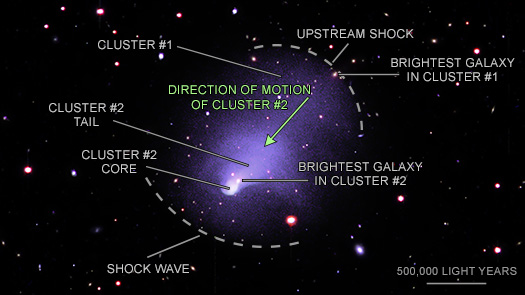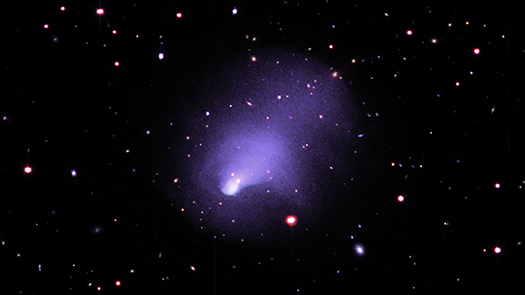Colossal Collisions Linked to Solar System Science
A new study shows a deep connection between some of the largest, most energetic events in the Universe and much smaller, weaker ones powered by our own Sun.
The results come from a long observation with NASA's Chandra X-ray Observatory of Abell 2146, a pair of colliding galaxy clusters located about 2.8 billion light years from Earth. The new study was led by Helen Russell of the University of Nottingham in the United Kingdom.
Galaxy clusters contain hundreds of galaxies and huge amounts of hot gas and dark matter and are among the largest structures in the Universe. Collisions between galaxy clusters release enormous amounts of energy unlike anything witnessed since the big bang and provide scientists with physics laboratories that are unavailable here on Earth.
In this composite image of Abell 2146, Chandra X-ray data (purple) shows hot gas, and Subaru Telescope optical data shows galaxies (red and white). One cluster (labeled #2) is moving towards the bottom left in the direction shown and plowing through the other cluster (#1). The hot gas in the former is pushing out a shock wave, like a sonic boom generated by a supersonic jet, as it collides with the hot gas in the other cluster.
The shock wave is about 1.6 million light years long and is most easily seen in a version of the X-ray image that has been processed to emphasize sharp features. Also labeled are the central core of hot gas in cluster #2, and the tail of gas it has left behind. A second shock wave of similar size is seen behind the collision. Called an "upstream shock," features like this arise from the complex interplay of stripped gas from the infalling cluster and the surrounding cluster gas. The brightest and most massive galaxy in each cluster is also labeled.

Shock waves like those generated by a supersonic jet are collisional shocks, involving direct collisions between particles. In Earth's atmosphere near sea level, gas particles typically travel only about 4 millionths of an inch before colliding with another particle.
Conversely, in galaxy clusters and in the solar wind — streams of particles blown away from the Sun — direct collisions between particles occur too rarely to produce shock waves because the gas is so diffuse, with incredibly low density. For example, in galaxy clusters particles typically must travel about 30,000 to 50,000 light years before colliding. Instead, the shocks in these cosmic environments are "collisionless," generated by interactions between charged particles and magnetic fields.
Chandra observed Abell 2146 for a total of about 23 days, giving the deepest X-ray image yet obtained of shock fronts in a galaxy cluster. The two shock fronts in Abell 2146 are among the brightest and clearest shock fronts known among galaxy clusters.
Using this powerful data, Russell and her team studied the gas temperature behind the shock waves in Abell 2146. They showed that electrons have been mainly heated by compression of gas by the shock, an effect like that seen in the solar wind. The rest of the heating occurred by collisions between particles. Because the gas is so diffuse this additional heating took place slowly, over about 200 million years.
Chandra makes such sharp images that it can actually measure how much random gas motions are blurring shock front that is expected from theory to be much narrower. For this cluster, they measure random gas motions of around 650,000 miles per hour.
Collisionless shock waves are important in several other fields of research. For example, the radiation produced by shocks in the solar wind can negatively impact spacecraft operation, as well as the safety of humans in space.
A paper describing these results was accepted by The Monthly Notices of the Royal Astronomical Society and appears online. The authors are Helen Russell (University of Nottingham, United Kingdom), Paul Nulsen (Center for Astrophysics Harvard | Smithsonian, or CfA), Damiano Caprioli (University of Chicago), Urmila Chadayammuri (CfA), Andy Fabian (Cambridge University, United Kingdom), Matthew Kunz (Princeton University), Brian McNamara (University of Waterloo, Canada), Jeremy Sanders (Max Planck Institute for Extraterrestrial Physics, Germany), Annabelle Richard-Laferriere (Cambridge University, United Kingdom), Maya Beleznay (Massachusetts Institute of Technology), Becky Canning (University of Portsmouth, United Kingdom), Julie Hlavacek-Larrondo (University of Montreal, Canada), and Lindsay King (University of Texas at Dallas).
NASA's Marshall Space Flight Center manages the Chandra program. The Smithsonian Astrophysical Observatory's Chandra X-ray Center controls science operations from Cambridge, Massachusetts, and flight operations from Burlington, Massachusetts.

